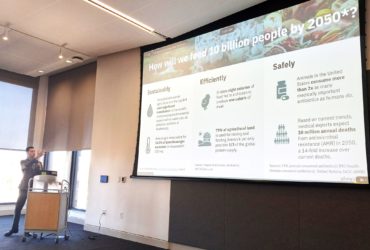Why we want an alternative protein revolution: An Interview with Nathan Ahlgrim at GFI (Part 1)
Highlights:
- The alternative proteins market has been expanding, but breaking into the market is a huge hurdle, requiring a delicious product and effective marketing.
- Nathan’s vision is a world where alternative proteins are no longer alternative but the default option, quite similar to the renewable energy transition.
- Food additives and animal-sourced proteins like gelatin or stabilizer are another big part of the food system that can be fulfilled by precision fermentation, an alternative protein technology.
Maggie:
Thank you for chatting with me today! Can you tell me about GFI and its role in supporting the alternative protein industry?
Nathan:
The Good Food Institute (GFI) is a non-profit think tank and international network that aim to build a sustainable food system through alternative proteins. We focus on science and technology because research is needed to get that taste equity or better than traditional needs. A lot has to be done with scale to bring the cost down and increase the market share. We also work on policy because we need government funding and support, similar to renewable energy initiatives. Additionally, we assist start-ups to minimize the barriers to entry and navigating the regulatory and business landscape through corporate engagement. Our goal is to facilitate innovation and allow those innovations to get to the consumers.
Maggie:
What’s the current state of this alternative protein industry?
Nathan:
The alternative proteins market has been expanding, but it is still small compared to the meat market. For example, by the end of 2021, there was about 16% market share of plant-based milk, which demonstrated that incredible push from the consumer side, but plant-based meat is only at 1.4%. Breaking into the market is a huge hurdle, requiring a delicious product and effective marketing. If you put plant-based meats at the corner in the grocery store, it is a lot harder to expand the market. But if it is right next to all of the other meat, people can see it and try it. While some products are already comparable or even better than traditional meat close in my personal estimation, consumer skepticism remains a challenge sometimes.
Maggie:
What is the end goal for GFI in terms of market share?
Nathan:
Our vision is a world where alternative proteins are no longer alternative but the default option, without asking anyone to give anything up, which is why we want the product to be as delicious if not more. I personally do not see a reason why we could not eventually get to 100% of the market. It would be incredibly challenging now, but I view it as quite similar to the renewable energy transition. The transition away from fossil fuels 100% will be incredibly hard, but, that is a target that we need to strive for. Our goal is to engage not just those who are already interested in alternative proteins, but also traditional agriculture and scientists. We have already supported students in spinning out their research into two new start-up companies focused on alternative protein pet food and seafood.
Maggie:
I’m really excited to hear that people are working on pet food. Most people are only familiar with plant-based meat, but there are so much more animal proteins in the food system that are ignored. The revolution is about changing everything.
Nathan:
Absolutely! Here we can see the power of the synergy to meet the complete needs of this ecosystem. For example, we know that precision fermentation can fill the need of a lot of food additives or animal-sourced protein like gelatin or any sort of stabilizer. So you can have the exact same components but without the need for animals. When you combine that with plant-based meats, then you can have a more precise nutritional profile, the possibilities are endless. Food additives and non-meat portions of animal agriculture are also something I was less familiar with before I started my career. I did not realize how large of an impact those also played in all of the exact same problems that we think about in terms of meat production.
Maggie:
One thing I was less familiar with before I start is the animal welfare aspect of agriculture. My first job was actually working in a meat lab, which gives me the opportunity to tour a meat plant, I watched the whole meat production and It’s just shocking for me to see how it takes one second to make a life become a meat.
Nathan:
That it is so hard to see the realities that go into making our food system and not be dramatically infected by that. Our founder Bruce always says that people do not eat meat because of how it is produced, they eat meat in spite of how it is produced. I don’t think anyone enjoys the idea of a slaughterhouse, that’s why our grocery stores are packaged the way they are you don’t see the animal when you go to the meat section. I was at a banquet in which they presented a whole bird, and the folks who traditionally eat meat were not able to convince themselves to eat that bird, because it reminded them of the living creature that it used to be. I think the more that people are aware of that, it increases the value that alternative proteins provide, and we no longer have to live in that reality.
Maggie:
This reminds me of the reason why we say we eat beef and pork instead of cow and pig. When the French took over England in 1066, the lower-class Anglo-Saxon farmers and hunters use old English words to describe the animals they raise and killed, whereas the wealthy elite who don’t need to get their hands bloody would describe the cuisine with French words. That’s why “beef” and “pork” sounds like French words “boeuf” and “porc”. This linguistic distinction between live animals and meat has a subtle change to our psychology, as we are trying to avoid the fact that a once-living animal needs to be slaughtered to produce meat, and therefore feel better about eating them. Now that we have all the amazing products on the market, we don’t have to turn our heads away from this necessary cruelty in our humanity anymore, because this cruelty is no longer necessary. With the pace of this movement, we can start to embrace the bright side of our humanity.
About the Author:
 Wanxin Xue | Linkedin
Wanxin Xue | Linkedin
Wanxin is currently pursuing her undergraduate degree in Food Science at the University of Guelph. Wanxin also goes by the name Maggie, because her parents met each other at Maggi seasoning sauce plant and fell in love, which set the tone for Wanxin picking Food Science as her study and career choice. Wanxin is also the President of the Food Science club at the University of Guelph, enjoying building the community of foodies and helping people know more about Food Science. Growing up in China and coming to Canada to study, Wanxin develops a strong appreciation towards different cultures. She loves traveling, making new friends and exploring local culture through the cuisine. In her free time, you can also find her juggling.






Leave a Reply